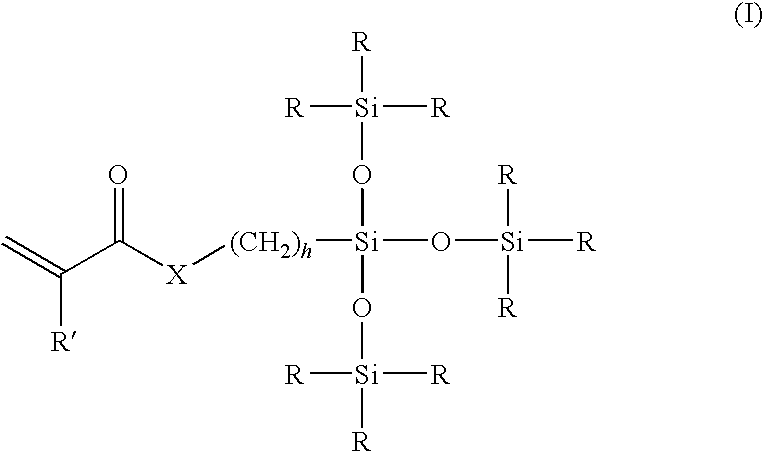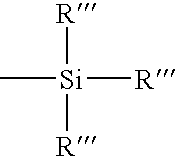High water content silicone hydrogels
a silicone hydrogel and high water content technology, applied in the direction of instruments, optical elements, transportation and packaging, etc., can solve the problems of inability to easily circumvent oxygen and inhibit the movement of the lens on the eye, and achieve the effect of suitable oxygen permeability and high water conten
- Summary
- Abstract
- Description
- Claims
- Application Information
AI Technical Summary
Benefits of technology
Problems solved by technology
Method used
Image
Examples
example 1
[0129]A base formulation was prepared containing N-vinyl-2-pyrrolidone (NVP) (90 weight percent) and 4-t-butyl-2-hydroxycyclohexyl methacrylate (TBE) (10 weight percent). To this formulation was added ethylene glycol dimethacrylate (EGDMA) (0.15 weight percent), 2-hydroxyethyl methacrylate (HEMA) vinyl carbonate (0.15 weight percent) and a cationic silicone based tris-methacrylate of the general structure as defined in Formula VII (5 weight percent) and Vazo™ 64 (azo bis-isobutylnitrile (AIBN)) (0.5 weight percent). The resultant mixture was thermally cured for about 3 hours. The resulting film had a modulus of 40 g / mm2, a water content of 83% and a Dk of 51 barrers.
example 2
[0130]A base formulation was prepared containing NVP (90 weight percent) and TBE (10 weight percent). To this formulation was added HEMA vinyl carbonate (0.30 weight percent), a silicone based methacrylate (15 weight percent) and AIBN (0.5 weight percent). The resultant monomeric mixture was thermally cured for about 3 hours. The resulting film had a modulus of 52 g / mm2, a water content of 79% and a Dk of 42 barrers. The silicone based methacrylate used in this example is of the formula:
[0131]
example 3
[0132]A base formulation was prepared containing NVP (90 weight percent) and TBE (5 weight percent). To this formulation was added allyl methacrylate (0.38 weight percent), ethyleneglycol dimethacrylate (EGDMA) (0.38 weight percent), tris(trimethoxysilylpropyl)methacrylate (TRIS-MA)(5 weight percent) and AIBN (0.5 weight percent). The resultant monomeric mixture was thermally cured for about 3 hours. The resulting lens had a modulus of ˜50 g / mm2, a water content of ˜78% and a Dk of ˜42 barrers.
PUM
| Property | Measurement | Unit |
|---|---|---|
| weight percent | aaaaa | aaaaa |
| contact angle | aaaaa | aaaaa |
| weight percent | aaaaa | aaaaa |
Abstract
Description
Claims
Application Information
 Login to View More
Login to View More - R&D
- Intellectual Property
- Life Sciences
- Materials
- Tech Scout
- Unparalleled Data Quality
- Higher Quality Content
- 60% Fewer Hallucinations
Browse by: Latest US Patents, China's latest patents, Technical Efficacy Thesaurus, Application Domain, Technology Topic, Popular Technical Reports.
© 2025 PatSnap. All rights reserved.Legal|Privacy policy|Modern Slavery Act Transparency Statement|Sitemap|About US| Contact US: help@patsnap.com



